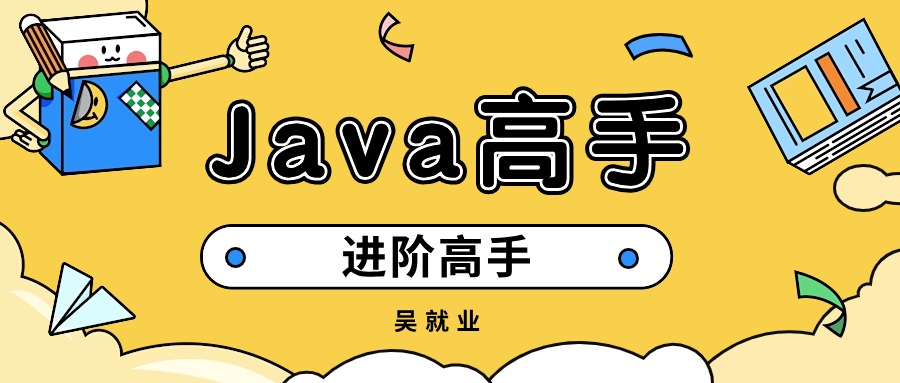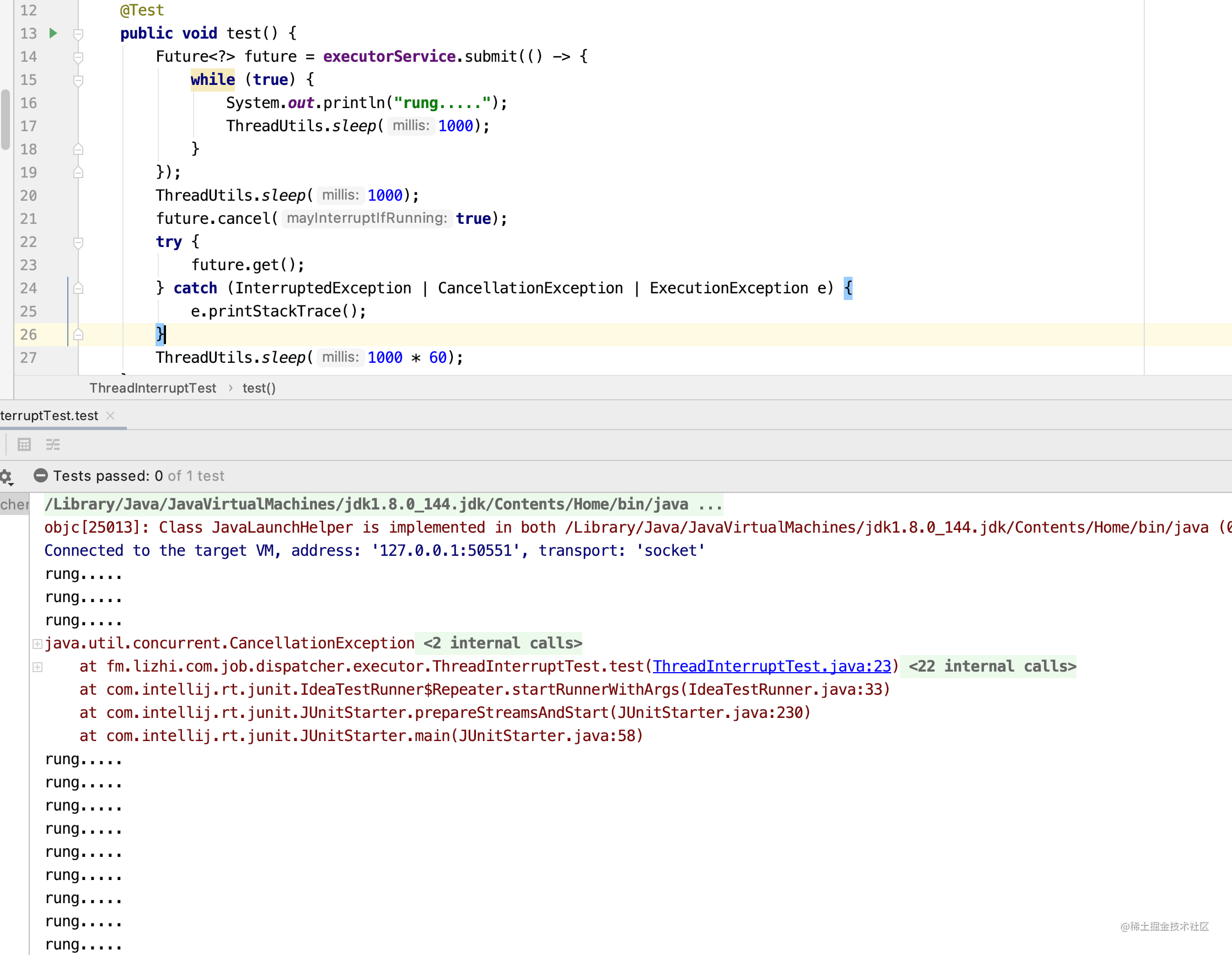
 Java进阶高手 专栏收录该内容,点击查看专栏更多内容
Java进阶高手 专栏收录该内容,点击查看专栏更多内容原创 吴就业 267 0 2021-12-11
本文为博主原创文章,未经博主允许不得转载。
本文链接:https://wujiuye.com/article/43a6fbf18b794dcf92f671a083fd78bf
作者:吴就业
链接:https://wujiuye.com/article/43a6fbf18b794dcf92f671a083fd78bf
来源:吴就业的网络日记
本文为博主原创文章,未经博主允许不得转载。
本篇文章写于2021年12月11日,从公众号|掘金|CSDN手工同步过来(博客搬家),本篇为原创文章。
在Java中,用于终止一个正在运行中的线程,并非调用stop方法,而是自行设置一个标志位,在安全点检测标志位,决定是否退出,但也可能会因为线程被挂起,无法走到标志位。因此,Java线程提供了中断机制,Thread类提供了中断线程执行的调用方法:interrupt,用于中断因线程挂起的等待,调用interrupt方法后,线程会被唤醒,待下次cpu调度就会继续执行中断后的代码 。
我们经常会调用Thread#sleep、Object#wait、Queue#poll等方法,并要求我们处理InterruptedException异常。 那么,抛出InterruptedException后,线程会终止吗?
如果不捕获InterruptedException,那么线程就会因为异常终止,是因为异常终止,并不是因为被中断。如果捕获了InterruptedException,那么线程就不会终止。
中断,其实只是jvm用于唤醒因锁竞争、I/O操作、休眠等待被挂起的线程,并设置一个中断标志,我们可以利用这个标志去做一些处理。比如,当我们发送消息给远程服务器,并休眠等待结果时,如果线程被唤醒,并设置了中断标志,此时我们可以知道,并非等到结果被唤醒的,而是被中断唤醒的,可以决定是继续等待结果,还是放弃等待。
xxl-job提供取消任务操作,而任何运行中的线程,都只能利用中断机制去结束线程任务,所以我们想要任务支持被取消,那么在写定时任务时,一定要考虑清楚,是不是应该捕获InterruptedException,如何利用中断标志结束任务,否则将会导致任务无法被取消。
我们来看个案例:
@Test
public void test() {
ExecutorService executorService = Executors.newSingleThreadExecutor();
Future<?> future = executorService.submit(() -> {
while (true) {
System.out.println( "rung....." );
ThreadUtils.sleep(1000);
}
});
ThreadUtils.sleep(1000);
future.cancel(true);
try {
future.get();
} catch (InterruptedException | CancellationException | ExecutionException e) {
e.printStackTrace();
}
ThreadUtils.sleep(1000 * 60);
}
此案例创建了只有一个线程的线程池,提交了一个死循序任务,该任务只调用ThreadUtils.sleep方法进入休眠。平常我们调用Thread.sleep方法都要求是否捕获中断异常,很多时候我们都会嫌弃麻烦,就用一个工具类提供sleep方法,然后将中断异常捕获,如ThreadUtils:
public class ThreadUtils {
public static void sleep(long millis) {
try {
Thread.sleep(millis);
} catch (InterruptedException ignored) {
}
}
}
此案例中,由于我们捕获了中断异常,因此这会导致任务并不会被终止,只是当我们调用future的get方法时会抛出CancellationException异常,如下图所示。

任务依然在运行中……
因此,在实际开发中,如果我们开发的Job也是如此,将会导致Job无法被中断取消,直至Job执行完成或者重启。在开发Job时,应当合理考虑是否要捕获中断异常。
如果我们希望案例中的任务能够被终止,我们可以这样处理:
@Test
public void test() {
ExecutorService executorService = Executors.newSingleThreadExecutor();
Future<?> future = executorService.submit(() -> {
while (true) {
System.out.println( "rung....." );
try {
Thread.sleep(1000);
} catch (InterruptedException ex) {
System.err.println( "interrupted" );
return; // 退出死循环
}
}
});
ThreadUtils.sleep(1000);
future.cancel(true);
try {
future.get();
} catch (InterruptedException | CancellationException | ExecutionException e) {
e.printStackTrace();
}
ThreadUtils.sleep(1000 * 60);
}
关于Thread的interrupt方法,注释描述的大致意思如下:
怎么理解中断标志呢?
“如果被中断的线程,当前是调用Object#wait、Thread#join、Thread#sleep方法,将收到InterruptedException,并且会清除中断标志”,案例中的代码正好符合这点,如果我们将案例代码改为如下:
@Test
public void test() {
ExecutorService executorService = Executors.newSingleThreadExecutor();
Future<?> future = executorService.submit(() -> {
while (!Thread.interrupted()) {
System.out.println( "rung....." );
try {
Thread.sleep(1000);
} catch (InterruptedException ex) {
System.err.println( "interrupted" );
}
}
});
ThreadUtils.sleep(1000);
future.cancel(true);
try {
future.get();
} catch (InterruptedException | CancellationException | ExecutionException e) {
e.printStackTrace();
}
ThreadUtils.sleep(1000 * 60);
}
执行这段代码你会发现,死循环根本没有退出,正是因为Thread#sleep方法被中断,JVM并不会设置中断标志,只是抛出InterruptedException异常。
其它情况下,JVM只会设置中断标志,并不会抛出InterruptedException。如果我们不处理中断信号,那么中断信号并不会影响程序的继续执行。
@Test
public void test2() {
ExecutorService executorService = Executors.newSingleThreadExecutor();
Future<?> future = executorService.submit(() -> {
int number = 0;
while (!Thread.interrupted()) {
number++;
}
System.out.println(number);
});
ThreadUtils.sleep(1000);
future.cancel(true);
try {
future.get();
} catch (InterruptedException | CancellationException | ExecutionException e) {
e.printStackTrace();
}
ThreadUtils.sleep(1000 * 60);
}
此案例并没有I/O操作导致的阻塞,因为调用中断方法后,线程只是设置了中断标志,我们用中断标志作为循序的退出条件,运行此案例,我们将看到,线程中断后,任务终止。反之,如果我们不处理中断标志,那么就等着IDEA进程卡掉吧。
声明:公众号、CSDN、掘金的曾用名:“Java艺术”,因此您可能看到一些早期的文章的图片有“Java艺术”的水印。

jeprof命令报错:`The first profile should be a remote form to use /pprof/symbol`,这是因为命令需要程序源文件(原二进制文件)。另外`FATAL ERROR: Did not specify profile file`错误也是一样的问题。
订阅
订阅新文章发布通知吧,不错过精彩内容!
输入邮箱,提交后我们会给您发送一封邮件,您需点击邮件中的链接完成订阅设置。